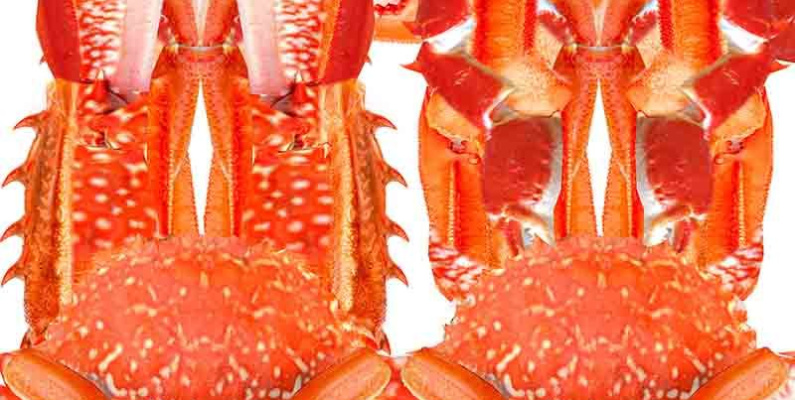
In Otago Museum’s latest exhibition, Current, nine contemporary artists and designers were invited to create a new work of art inspired by an object from the Museum’s diverse dress and textile collection. Fashion designer Max Mollison selected a 1950s beaded cocktail hat as the starting point for his crab-inspired fashion feast, Keep your filthy paws off my silky claws.
Exhibition Curator Jamie Metzger and Curator – Natural Science, Emma Burns discuss what happens when fashion takes its inspiration from under the sea.
What is a crab?
Boiled down, crab is mostly a concept of shape, within the decapod crustaceans. Compared to the narrow, elongated ancestral body form seen in lobsters, shrimps and prawns, some decapods have evolved to become wider, flatter and compact – the shape we recognise as crab-like.
This evolutionary transition is called carcinisation. The crab-like body form has evolved independently in different groups of decapod crustaceans. Some species are more carcinised than others.
A crab is whatever you want it to be
Museum records described the cocktail hat as a ‘pink shaped crown covered with plastic crabs claws…’ While the beads share some of the characteristics of crab claws, in colour and form, the pincer structure is not present.

Cocktail hat, 1950s. Gift of Mrs H Smith Estate; Otago Museum Collection

Detail of plastic beads. Cocktail hat, 1950s. Gift of Mrs H Smith Estate; Otago Museum Collection
While the beads were technically not crab claws, the boundary between what is crab and what is not, is open to interpretation. Gerhard Scholtz, Humboldt University of Berlin, said, “A crab is whatever we perceive as a crab.”
Anatomy of a crab
The starting point for Max’s inspiration was the crab-claw shape, a form which we have become accustomed to seeing in popular culture – from Disney’s Sebastian to SpongeBob SquarePants’ Mr Krabs to Futurama’s Zoidberg; some of our favourite fictional cartoon characters have exaggerated crab features.
The exoskeleton of a crab is referenced in the form of Max’s design. The jacket and pants are lined with denim, adding a stiffness which mimics the armour-like properties of a crab shell. Shoulder spikes are translated into the silhouette of the jacket and pants, while the frayed edge resembles hairs often seen on the margin of the legs and body of decapods.

Keep your filthy paws off my silky claws. Jacket. Image courtesy of Max Mollison.

Keep your filthy paws off my silky claws. Detail of pants. Image courtesy of Max Mollison.

Keep your filthy paws off my silky claws. Detail of jacket. Image courtesy of Max Mollison.
Crab is delicious
When most people are asked what a crab is, they simply reply, “Delicious”, conjuring thoughts of succulent dishes of Singapore chilli crab (mud crab, Scylla serrata), San Francisco garlic roast crab (Dungeness crab, Metacarcinus magister) or Maryland’s crabby patties (made from Chesapeake blue crab, Callinectes sapidus).
Max alludes to the idea of crabs as delicious food through the inclusion of crab bibs. Designed to protect clothes from crab juices, the bibs incorporate applique crab motifs, dripping with sweet chilli sauce and mayonnaise (white paint) encased in glue. The end result is both gluttonous and intriguing.

Keep your filthy paws off my silky claws. Crab bib. Image courtesy of Max Mollison.

Keep your filthy paws off my silky claws. Detail of crab bib. Image courtesy of Max Mollison.
Max chose to display his work on angled trays covered in tin foil. The silver provides a contrast to the vibrant orange of the custom-printed silk, and arranging the pieces on a bed of foil presents them in a culinary context. The all-you-can-eat style of display conjures up ideas of consumption of crab versus fast fashion.
We associate crustaceans with a pinky-red colour, but in the wild, crabs are more likely to be shades of blue, grey or green, which help them blend in with their surroundings. Their change in colouration happens when they are heated – allowing the colour of the chemical astaxanthin, which gives the reddish hue, to emerge.
Max’s custom-printed silk, a pattern of cooked Dungeness crab and king crab, meets our crab colour palette expectations. The merging shapes create a camouflage texture, ironic considering crabs spend a lot of time trying to conceal themselves.

Custom crab fabric pattern. Image courtesy of Max Mollison.
Feeling a little crabby
The term “crabby” as a synonym for grumpiness when barely provoked, probably stems from the idea that crabs are best left alone, but quickly deliver a painful pinch if disturbed.
Part of Max’s exhibition promotion included releasing a series of Steal his/her look videos and imagery of crab references found in contemporary pop culture.
Accessorising like a crab
Being so damn tasty creates a daily struggle for many crabs. One strategy is to stay as hidden as possible. Decorator crabs collect found objects and stick them to their carapaces. In the watery world of crabs, these are usually pieces of seaweed, sponges and anemones. As settlers, hermit crabs collect whole shells to retreat into. Crabs are guilty as charged when it comes to over-accessorising; they are not ‘taking one thing off’ before they leave the house, as Coco would advise.
Max referred to this accessorising behavior in his design, with the addition of found items, including lost lighters, takeaway KFC napkins, key rings and carabiners. In this scenario, more is more.

Keep your filthy paws off my silky claws. Crab bib with KFC napkin charm. Image courtesy of Max Mollison.

Keep your filthy paws off my silky claws. Bikini. Image courtesy of Max Mollison.
